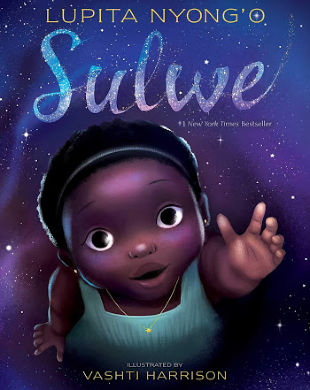If you haven't already been won over by the cover of the book pictured here, take a moment to gaze at illustrator Vashti Harrison's heart-stirring art. When you hold Sulwe in your hands, you can shift its angle to see a single star appear in each of the eyes of this young girl, Sulwe, in addition to the more readily visible one on her necklace. These bright adornments echo the meaning of her name: Star.
The open, innocent trust that you see in Sulwe's expression nearly gets crushed at the start of the book. She cannot understand why her skin is the color of midnight, when her mother's is the color of dawn, her father's the color of dusk, and her sister's the color of high noon. She just doesn't feel like she fits in, especially when children at school give her derogatory names like "Blackie" and "Darky."
The pictures and text grow increasingly heartbreaking for anyone who has ever tried to bolster a child's self-esteem. Sulwe finds the biggest eraser she can and tries to remove some of her color, wincing with determination. We see her spread her mother's light make-up all over her skin and sit on the floor surrounded by popcorn, bananas, cauliflower, milk, cheese, and white bread, trying to eat "only the lightest, brightest foods." She tries praying at bedtime for a miracle yet wakes up with "not a trace of daylight in her midnight skin."
Her deeply understanding mother sees her distress and reminds her of the meaning of her name and of how beautiful she finds Sulwe. "But you can't rely on what you look like to make you feel beautiful, my sweet. Real beauty comes from your mind and your heart. It begins wtih how you see yourself, not how others see you."
Still, Sulwe cannot comprehend how she can be a star ... until one evening a shooting star appears at her window and invites her on a nighttime journey. The extraordinary mythology which develops at this point, revolving around the reconciliation of opposites and their need for each other, makes an already arrestingly beautiful book even more profound. What emerges is an acceptance of light and dark that requires neither to change in the slightest.
Sulwe parts the fabric of prejudice, colorism in particular. Kenyan actress and producer Lupita Noyong'o and New York Times bestselling illustrator Vashti Harrison could not have done a finer job of convincing four to eight year olds that they have a bright beauty all their own.
